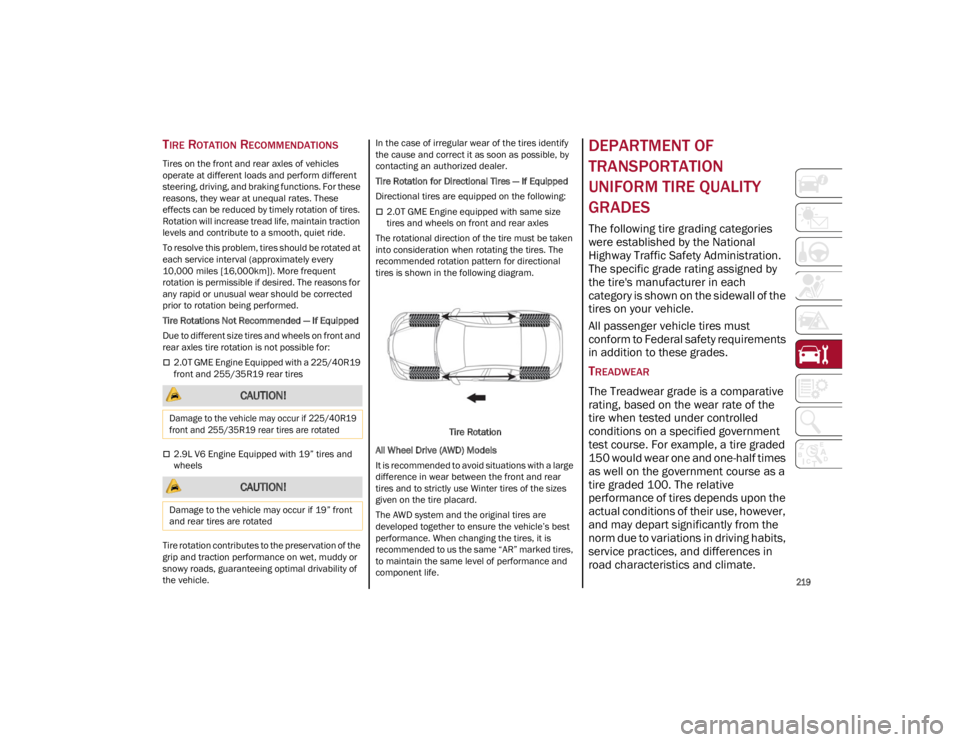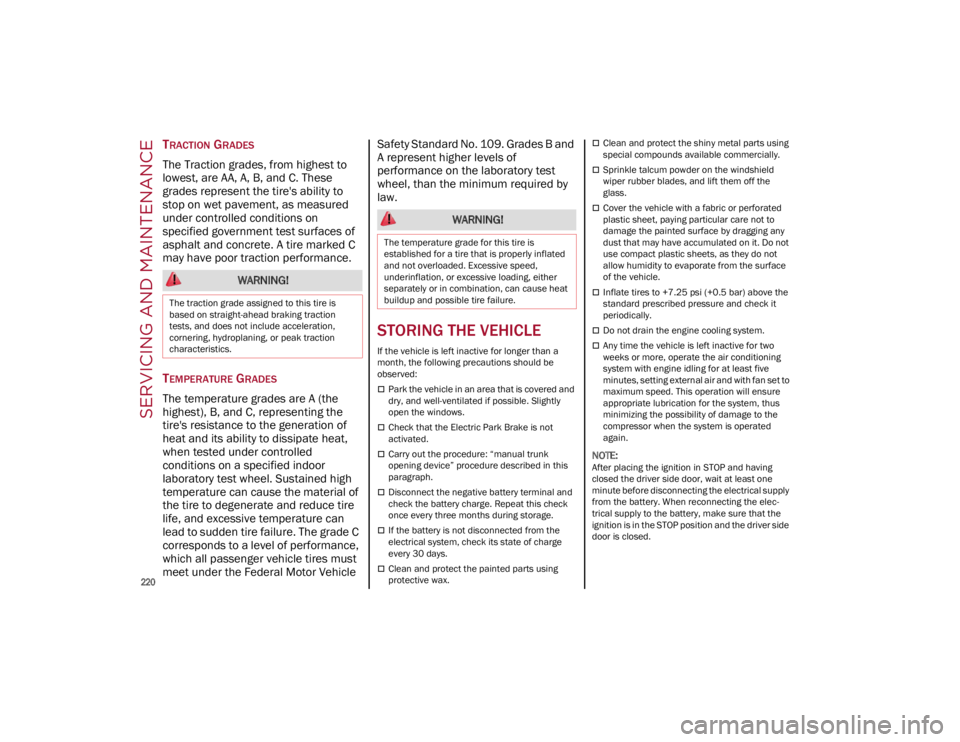2022 ALFA ROMEO GIULIA traction control
[x] Cancel search: traction controlPage 221 of 248

219
TIRE ROTATION RECOMMENDATIONS
Tires on the front and rear axles of vehicles
operate at different loads and perform different
steering, driving, and braking functions. For these
reasons, they wear at unequal rates. These
effects can be reduced by timely rotation of tires.
Rotation will increase tread life, maintain traction
levels and contribute to a smooth, quiet ride.
To resolve this problem, tires should be rotated at
each service interval (approximately every
10,000 miles [16,000km]). More frequent
rotation is permissible if desired. The reasons for
any rapid or unusual wear should be corrected
prior to rotation being performed.
Tire Rotations Not Recommended — If Equipped
Due to different size tires and wheels on front and
rear axles tire rotation is not possible for:
2.0T GME Engine Equipped with a 225/40R19
front and 255/35R19 rear tires
2.9L V6 Engine Equipped with 19” tires and
wheels
Tire rotation contributes to the preservation of the
grip and traction performance on wet, muddy or
snowy roads, guaranteeing optimal drivability of
the vehicle. In the case of irregular wear of the tires identify
the cause and correct it as soon as possible, by
contacting an authorized dealer.
Tire Rotation for Directional Tires — If Equipped
Directional tires are equipped on the following:
2.0T GME Engine equipped with same size
tires and wheels on front and rear axles
The rotational direction of the tire must be taken
into consideration when rotating the tires. The
recommended rotation pattern for directional
tires is shown in the following diagram.
Tire Rotation
All Wheel Drive (AWD) Models
It is recommended to avoid situations with a large
difference in wear between the front and rear
tires and to strictly use Winter tires of the sizes
given on the tire placard.
The AWD system and the original tires are
developed together to ensure the vehicle’s best
performance. When changing the tires, it is
recommended to us the same “AR” marked tires,
to maintain the same level of performance and
component life.
DEPARTMENT OF
TRANSPORTATION
UNIFORM TIRE QUALITY
GRADES
The following tire grading categories
were established by the National
Highway Traffic Safety Administration.
The specific grade rating assigned by
the tire's manufacturer in each
category is shown on the sidewall of the
tires on your vehicle.
All passenger vehicle tires must
conform to Federal safety requirements
in addition to these grades.
TREADWEAR
The Treadwear grade is a comparative
rating, based on the wear rate of the
tire when tested under controlled
conditions on a specified government
test course. For example, a tire graded
150 would wear one and one-half times
as well on the government course as a
tire graded 100. The relative
performance of tires depends upon the
actual conditions of their use, however,
and may depart significantly from the
norm due to variations in driving habits,
service practices, and differences in
road characteristics and climate. CAUTION!
Damage to the vehicle may occur if 225/40R19
front and 255/35R19 rear tires are rotated
CAUTION!
Damage to the vehicle may occur if 19” front
and rear tires are rotated
22_GA_OM_EN_USC_t.book Page 219
Page 222 of 248

SERVICING AND MAINTENANCE
220
TRACTION GRADES
The Traction grades, from highest to
lowest, are AA, A, B, and C. These
grades represent the tire's ability to
stop on wet pavement, as measured
under controlled conditions on
specified government test surfaces of
asphalt and concrete. A tire marked C
may have poor traction performance.
TEMPERATURE GRADES
The temperature grades are A (the
highest), B, and C, representing the
tire's resistance to the generation of
heat and its ability to dissipate heat,
when tested under controlled
conditions on a specified indoor
laboratory test wheel. Sustained high
temperature can cause the material of
the tire to degenerate and reduce tire
life, and excessive temperature can
lead to sudden tire failure. The grade C
corresponds to a level of performance,
which all passenger vehicle tires must
meet under the Federal Motor Vehicle Safety Standard No. 109. Grades B and
A represent higher levels of
performance on the laboratory test
wheel, than the minimum required by
law.
STORING THE VEHICLE
If the vehicle is left inactive for longer than a
month, the following precautions should be
observed:
Park the vehicle in an area that is covered and
dry, and well-ventilated if possible. Slightly
open the windows.
Check that the Electric Park Brake is not
activated.
Carry out the procedure: “manual trunk
opening device” procedure described in this
paragraph.
Disconnect the negative battery terminal and
check the battery charge. Repeat this check
once every three months during storage.
If the battery is not disconnected from the
electrical system, check its state of charge
every 30 days.
Clean and protect the painted parts using
protective wax.
Clean and protect the shiny metal parts using
special compounds available commercially.
Sprinkle talcum powder on the windshield
wiper rubber blades, and lift them off the
glass.
Cover the vehicle with a fabric or perforated
plastic sheet, paying particular care not to
damage the painted surface by dragging any
dust that may have accumulated on it. Do not
use compact plastic sheets, as they do not
allow humidity to evaporate from the surface
of the vehicle.
Inflate tires to +7.25 psi (+0.5 bar) above the
standard prescribed pressure and check it
periodically.
Do not drain the engine cooling system.
Any time the vehicle is left inactive for two
weeks or more, operate the air conditioning
system with engine idling for at least five
minutes, setting external air and with fan set to
maximum speed. This operation will ensure
appropriate lubrication for the system, thus
minimizing the possibility of damage to the
compressor when the system is operated
again.
NOTE:
After placing the ignition in STOP and having
closed the driver side door, wait at least one
minute before disconnecting the electrical supply
from the battery. When reconnecting the elec
-
trical supply to the battery, make sure that the
ignition is in the STOP position and the driver side
door is closed.
WARNING!
The traction grade assigned to this tire is
based on straight-ahead braking traction
tests, and does not include acceleration,
cornering, hydroplaning, or peak traction
characteristics.
WARNING!
The temperature grade for this tire is
established for a tire that is properly inflated
and not overloaded. Excessive speed,
underinflation, or excessive loading, either
separately or in combination, can cause heat
buildup and possible tire failure.
22_GA_OM_EN_USC_t.book Page 220
Page 227 of 248

225
POWER SUPPLY
TRANSMISSION
2.9L Engine
CycleFour
Number and position of cylinders 6 / V
Piston bore and stroke (mm) 86.5 × 82
Total displacement (cm³) 2,891
Compression ratio 9.3:1
Maximum power (SAE) (kW) 375
Maximum power (SAE) (HP) 505
Corresponding engine speed (RPM) 6,500
Maximum torque (SAE) (Nm) 600
Maximum torque (SAE) (ft-lb) 443
Corresponding engine speed (RPM) 2,500
Fuel 87 Octane (R+M)/2 Method Minimum, 91 Recommended, ethanol
percentage is 0–15%
Power Supply
2.0L Engine Electronic timed sequential injection with knock control
2.9L Engine Phased sequential electronic injection with knock control and variable
intake valve actuation
ModelTransmissionTraction
2.0L Engine Eight forward gears plus reverseRear-wheel drive
or
All-wheel drive
2.9L Engine Eight forward gears plus reverseRear
22_GA_OM_EN_USC_t.book Page 225
Page 245 of 248

243
T
Tie Down Hooks, Cargo ................................ 62
Tire And Loading Information Placard ......209
Tire Markings..............................................206
Tire Safety Information .............................. 206
Tire Service Kit ...........................................171
Tires .................................167, 212, 216, 219Aging (Life Of Tires) ................................ 215Air Pressure ............................................ 212
Compact Spare ...................................... 216
Flat Changing .........................................171
General Information......................212, 216
High Speed ............................................. 213
Inflation Pressure...................................212Life Of Tires ............................................ 215
Load Capacity.........................................209
Pressure Monitoring System (TPMS) ...... 72
Quality Grading....................................... 219
Radial......................................................214
Replacement ..........................................215
Safety .............................................206, 212
Sizes .......................................................207
Snow Tires ..............................................218
Spare Tires ............................................. 216
Spinning..................................................214
Tread Wear Indicators ...........................215
Tow Hooks ..................................................180
Towing Disabled Vehicle ....................................179 Towing Trailers ........................................... 125
TPMS (Tire Pressure Monitoring
System) ...................................................... 142
Traction Control System (TCS) .................. 131
Transmission ............................................. 225
Transporting Animals ................................ 127
Transporting Passengers .......................... 126
Transporting Pets ...................................... 166
Tread Wear Indicators ............................... 215
Trunk Lid (Deck Lid) .....................................61
Turn Signals ........................................... 44, 74
U
Uconnect Settings Customer Programmable Features.........26
Passive Entry Programming.....................26
Uniform Tire Quality Grades...................... 219
Universal Garage Door Opener (HomeLink®)
S..........................................39
Universal Transmitter ...................................39
Untwisting Procedure, Seat Belt............... 146
Use Of The Owner’s Manual .......................... 5
V
Vehicle Changes/Alterations ......................... 3
Vehicle Identification Number .................. 224
Vehicle Loading ................................ 125, 209 W
Warning Lights (Instrument Cluster
Descriptions) ................................................ 72
Warranty Information ................................ 237
Washer Fluid For Windshield/
Headlights .................................................. 190
Washers, Windshield ................................... 46
Weights ....................................................... 229
Wheel And Wheel Tire Care....................... 217
Wheel And Wheel Tire Trim ....................... 217
Wheels And Tires ....................................... 206
Wind Buffeting ............................................. 58
Windows (Cleaning) ................................... 222
Windshield Defroster ................................. 166
Windshield Washers .................................... 46
Windshield Wiper
Replacing Blades ................................... 194
Windshield Wipers ....................................... 46
Wipers, Intermittent ..................................... 46
Wipers, Rain Sensitive................................. 46
22_GA_OM_EN_USC_t.book Page 243